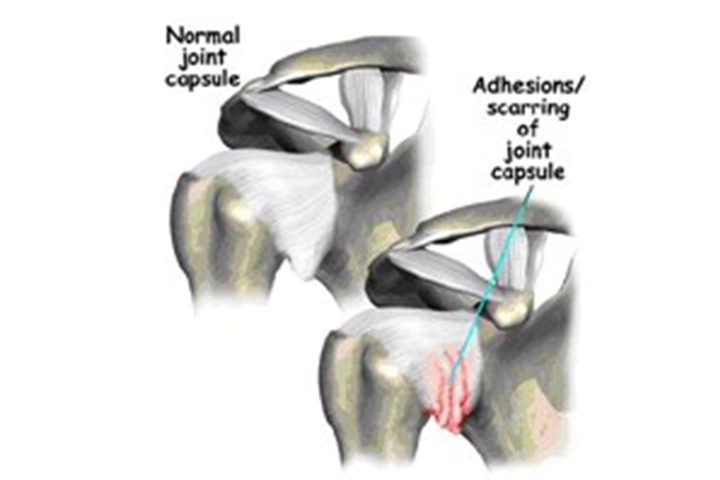A frozen shoulder is characterized by pain and loss of motion or stiffness in the shoulder. It affects about two percent of the general population. Frozen shoulder most commonly affects patients between the ages of 40 and 60 years, with no clear predisposition based on sex, arm dominance, or occupation

The causes of frozen shoulder are not fully understood. The process involves thickening and contracture of the capsule surrounding the shoulder joint leading to stiffness.
Frozen shoulder occurs much more commonly in individuals with diabetes, affecting 10 percent to 20 percent of these individuals. Other medical problems associated with an increased risk of a frozen shoulder include hypothyroidism, hyperthyroidism, Parkinson's disease, and cardiac disease or surgery.
A frozen shoulder can develop after a shoulder is immobilized for a long duration. Attempts to prevent a frozen shoulder include early Rehab of the shoulder after it has been injured.
Pain due to a frozen shoulder is usually dull or aching. It can be worsened with attempted motion and at night.
The hallmark of the disorder is restricted motion or stiffness in the shoulder. The affected individual cannot lift their arm upwards, comb their hair, or wear their clothes on their own.
Some physicians have described the normal course of a frozen shoulder as having three stages:
Stage one: In the "freezing" stage, the patient develops a slow onset of pain especially at night. As the pain worsens, the shoulder loses motion. This stage may last from six weeks to nine months.
Stage two: The "frozen" stage is marked by a slow improvement in pain, but the stiffness remains. This stage generally lasts four months to nine months.
Stage three: The final stage is the "thawing," during which shoulder motion slowly returns to normal. This generally lasts five months to 26 months.
An Orthopedic surgeon can diagnose a frozen shoulder based on the patient's symptoms and a physical examination.
X-rays or Dynamic MRI (magnetic resonance imaging) studies are sometimes used to rule out other causes of shoulder stiffness and pain, such as a rotator cuff tear.
Frozen shoulder will generally get better on its own. However, this takes some time, occasionally up to two to three years. Treatment is aimed at pain control and restoring motion. Your Orthopedic Surgeon may advise for Visscosupplements, PRP, and Growth factor injections based on the stage of the Frozen Shoulder and your physical activity and age.
Pain control can be achieved with anti-inflammatory medications. These can include pills taken by mouth, such as ibuprofen, or by injection in the joint, such as steroids.

Physical therapy is used to restore motion. This may be under the direct supervision of a physical therapist or via a home program. Therapy includes stretching or range-of-motion exercises for the shoulder. Sometimes, heat is used to help decrease pain. Examples of some of the exercises that might be recommended can be seen in the following figures.
If these methods fail, USG-guided nerve blocks are sometimes used to limit pain and allow more aggressive physical therapy.
More than 90 percent of patients improve with these relatively simple treatments & routine follow-up. Usually, the pain resolves and the motion improves. However, in some cases, even after several years the motion does not return completely and a small amount of stiffness remains. To avoid this, a closely coordinated treatment and rehab program under the supervision of Orthopedic Shoulder Surgeons and Sports Physiotherapists is a must.
Surgical intervention is considered when there is no improvement in pain or shoulder stiffness after an appropriate course of physical therapy. When other conservative treatments have failed, the patient must always consider that most individuals will get better if given sufficient time.
Surgical intervention is aimed at stretching or releasing the contracted joint capsule of the shoulder. The most common methods include manipulation under anesthesia and shoulder arthroscopic Capsular Release.
Manipulation under anesthesia involves putting the patient to sleep and forcing the shoulder to move. This process causes the capsule to stretch and breaks the adhesions.
With shoulder arthroscopy, the surgeon makes several small incisions around the shoulder. A small camera and instruments are inserted through the incisions. These instruments are used to release the tight portions of the joint capsule.
Often, manipulation and arthroscopy are used together in combination to obtain maximum results. Most patients have very good results with these procedures.
After surgery, physical therapy is very important to maintain the motion that was achieved with surgery. Recovery time varies, from six weeks to three months.
Know more about Frozen Shoulder treatment at CSI by filling out the Inquiry Form below or calling 011 4122 3333 to book an appointment.
